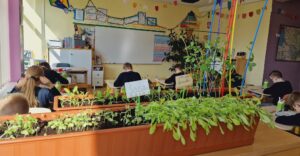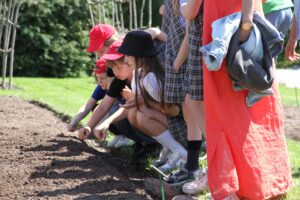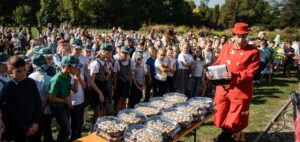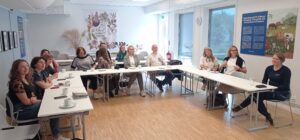
The project “Children & Young People – Sow, see and taste” was implemented
Over 1700 pupils and 93 teachers from 32 schools in Šiauliai County, Kaunas and Klaipėda were involved in the lessons, including the opportunity to observe the germination of seeds, grow microgreens in the classroom and harvest wheat and vegetables in the school yard. Together with their peers from Iceland and the Faroe Islands, they took part in the project “Children & Young People – Sow, see and taste”, which aims to get the younger generation interested in growing plants and to encourage them to think about the path our food takes to the plate. “Sow, see and taste” was implemented in Lithuanian schools by Nordic Council of Ministers Office in Lithuania together with Nordic Genetic Resources Center “NordGen” and the Association of Lithuanian University Botanical Gardens. All seed samples for the educational activities were collected from NordGen, which is also responsible for the Svalbard Global Seed Vault. The seeds selected were vegetables and cereals well adapted to the Nordic climate. The schools received them in the same packaging that has been stored for decades in special storage facilities, giving the children another reason to become interested and involved in the project.

In the classroom, pupils germinated and grew green beans, peas, cabbages, cucumbers, clover, thyme, lettuce and spinach, and in the field, they grew varieties of radishes, turnips and carrots, which illustrate the genetic diversity of vegetables, as well as the four main types of cereals – wheat, barley, oats and rye – that are important for Nordic and Baltic farms. This created an opportunity for pupil to discuss what genetic diversity is, why it is important, what genetic characteristics of seeds may be important for Nordic and Baltic conditions, and to compare the colour, size and shape of the different varieties of vegetables after harvest. For some, it was the first opportunity to taste turnips or to see the formerly common purple carrots.

Today, very few children help sow the crops or harvest the food that comes into our homes. No wonder children, and sometimes even adults, find it hard to connect the sliced bread in the supermarket or the carrot for lunch with the tiny seed that was once sown. However, it is our children who will have to carry on our work and take care of the planet so that it can continue to grow plants. All of humanity depends on plants for food, shelter, energy, animal feed and medicine, so understanding how a seed turns into a plant and what it needs to grow is essential knowledge for everyone, especially the younger generation.
Teachers who took part in the project praised the project’s idea and implementation. “We are very proud and happy to be part of this project because the children had so much fun. They felt what it means to have a land, a seed germinating. It is a very good project for today’s information society, when we see everything on screens, and here we had the opportunity to touch it live. This is priceless, and the children’s joy was immeasurable”, said Daina Gitana Paražinskienė, Headmistress of Kaunas “Varpelis” Primary School. Many teachers agreed that the success of the project was due to the opportunity for the pupils to engage in a wide range of practical activities: the children were particularly interested in seed germination, they were keen to water and weed the beds, measure the growing vegetables, and undertake other gardening tasks. The teachers interviewed unanimously agreed that the knowledge acquired during the project will have a lasting impact. Already, many of them have noticed that the children’s desire to taste vegetables, to learn more about healthy eating and to take an interest in plants has increased – when they go outside, they notice plants and ask “what’s that?”

“We are very pleased with this award as it confirms the need for such activities. By showing the path of food to our plate and the importance of biodiversity in a practical, fun and engaging way, we are contributing to healthy and sustainable habits. We believe that the younger generation will be more aware, respectful and caring not only for their own health and well-being, but also for the health and well-being of the Earth,” says Agnė Buraitytė, Climate, Environment and Digital Advisor at the Nordic Council of Ministers’ Office in Lithuania.

The project activities culminated in harvest festivals at the botanical gardens of Vytautas Magnus University, Klaipėda University and VU Šiauliai Academy. Representatives of the Nordic Genetic Resources Centre NordGen visited Lithuania and representatives of the botanical gardens involved in the project activities travelled to Sweden to learn more about its tasks and facilities. In Lithuania, the project “See, Sow and Taste!” in Lithuania, the Botanical Gardens of Vilnius University, Vytautas Magnus University, Klaipėda University and VU Šiauliai Academy provided space for the activities, advice for the teachers, and exhibitions of the plants used in the activities for the public. We would like to thank all the teachers and school administrators who were actively involved and gave the children the opportunity to get involved in the project activities.
The project was funded by the Nordic Council of Ministers’ Office in Lithuania. The contents of this publication are the sole responsibility of the project coordinators and do not necessarily reflect the views or policies of the Nordic Council of Ministers.
